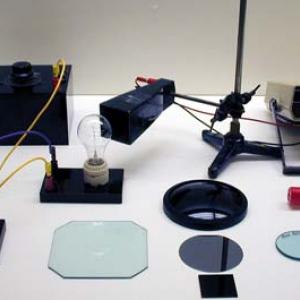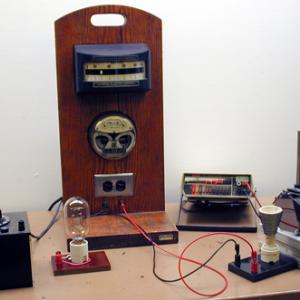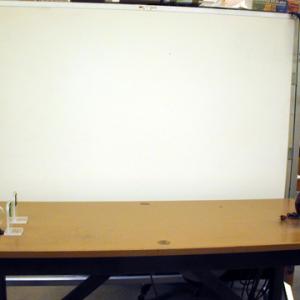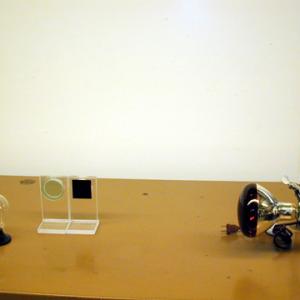College of Liberal Arts & Sciences
4B40.50 - Thermal Radiation - Absorption/Transmission
Place either the light bulb or the heating coil directly in front of the thermocouple. As you turn up the Variac there should be an immediate voltage increase on the meter. An ordinary 100 watt light bulb works just as well as the type of bulb shown in the picture.
Use the coil heater hooked to the Variac as the heat source. Hook the thermocouple horn to the voltmeter, (reading microvolts) as the detector. Turn the Variac to about 40 which will give heat but no visible radiation. By putting the glass between the detector and the heat source almost all the radiation can be absorbed. (Reading on the detector will go to background levels.) Remove the glass plate and insert the silicon wafer to show that even though you can't see through the wafer it is fairly transparent to I.R. Note: Wafer is fragile. BE CAREFUL. A light bulb will not work as the I.R. wavelength is to short.
An interesting variation of this is to use the silicon wafer filter in front of the thermocouple. Place a heater coil in front of this and plug it into the watt meter. Set the output energy at 300 watts and allow the system to come to equilibrium. (The reading of the voltmeter should be around 16.40.) Now take off the heater coil and put the 1000 watt light bulb in its place. Again turn up to 300 watts and allow the system to come up to equilibrium. (The reading on the voltmeter should be 14.40.) This basically shows the component of energy that is turned into light and not infrared radiation.
Substituting the voltmeter for a radiometer may be preferred in some situations. In this case use a heat lamp as your heat source. Point it at the radiometer from a distance of about 5 feet and observe the rotations rate of the vanes. Insert the heat absorbing filter and notice that the rotation rate slows to a stop. Insert the heat transmitting filter and notice that the vanes continue to turn although at a slightly slower rate than without the filter.
- Yi Jinn Lillian Chen, Jing-Yuan Ko, Shuo Hong Wang, Jiann-Shing Lih, Tzu-Chun Chen, Jeng-Fung Hung, "Ultraviolet and Infrared Light Blocked by Glass? Verifying Through Simple Experiments, "TPT, Vol. 62, #4, April 2024, p. 299.
- Carl Mungan, "Activating a Radiometer with a Hair Dryer", TPT, Vol. 53, #4, April 2015, p. 196.
- V. I. Hlafkouski, A. I. Pinchuk, "A New Way to Demonstrate the Radiometer as a Heat Engine", TPT, Vol. 53, # 2, Feb. 2015, p. 109.
- "Figuring Physics", TPT, Vol. 40, # 4, Apr. 2002, p. 252.
- "Figuring Physics", TPT, Vol. 34, # 9, Dec. 1996, p. 569.
- Harry Manos, "Demonstrating Heat Absorption", TPT, Vol. 24, # 8, Nov. 1986, p. 487.
- H- 3b: Wallace A. Hilton, "Radiation", Physics Demonstration Experiments.
- Janice VanCleave, "5, Coming Through", Engineering For Every Kid: Easy Activities That Make Learning Science Fun", p. 35.
- Yaakov Kraftmakher, "7.11, Detection of Thermal Radiation", Experiments and Demonstrations in Physics, ISBN 981-256-602-3, p. 349.
- "Infrared Demonstration Set: A Striking Demonstration of Selective Transmission", Sargent-Welch Catalog, 2003.
- Curt Suplee, "How heat gets around", Everyday Science Explained, National Geographic, p. 68.
- Curt Suplee, "Of sunlight and Earth", Everyday Science Explained, National Geographic, p. 106.
- Julius Sumner Miller, Q109 & A109, Millergrams I – Some Enchanting Questions for Enquiring Minds, p. 70 & 116.
- Julius Sumner Miller, Q124 & A124, Millergrams II – Some More Enchanting Questions for Enquiring Minds, p. 17 & 80.
Disclaimer: These demonstrations are provided only for illustrative use by persons affiliated with The University of Iowa and only under the direction of a trained instructor or physicist. The University of Iowa is not responsible for demonstrations performed by those using their own equipment or who choose to use this reference material for their own purpose. The demonstrations included here are within the public domain and can be found in materials contained in libraries, bookstores, and through electronic sources. Performing all or any portion of any of these demonstrations, with or without revisions not depicted here entails inherent risks. These risks include, without limitation, bodily injury (and possibly death), including risks to health that may be temporary or permanent and that may exacerbate a pre-existing medical condition; and property loss or damage. Anyone performing any part of these demonstrations, even with revisions, knowingly and voluntarily assumes all risks associated with them.




